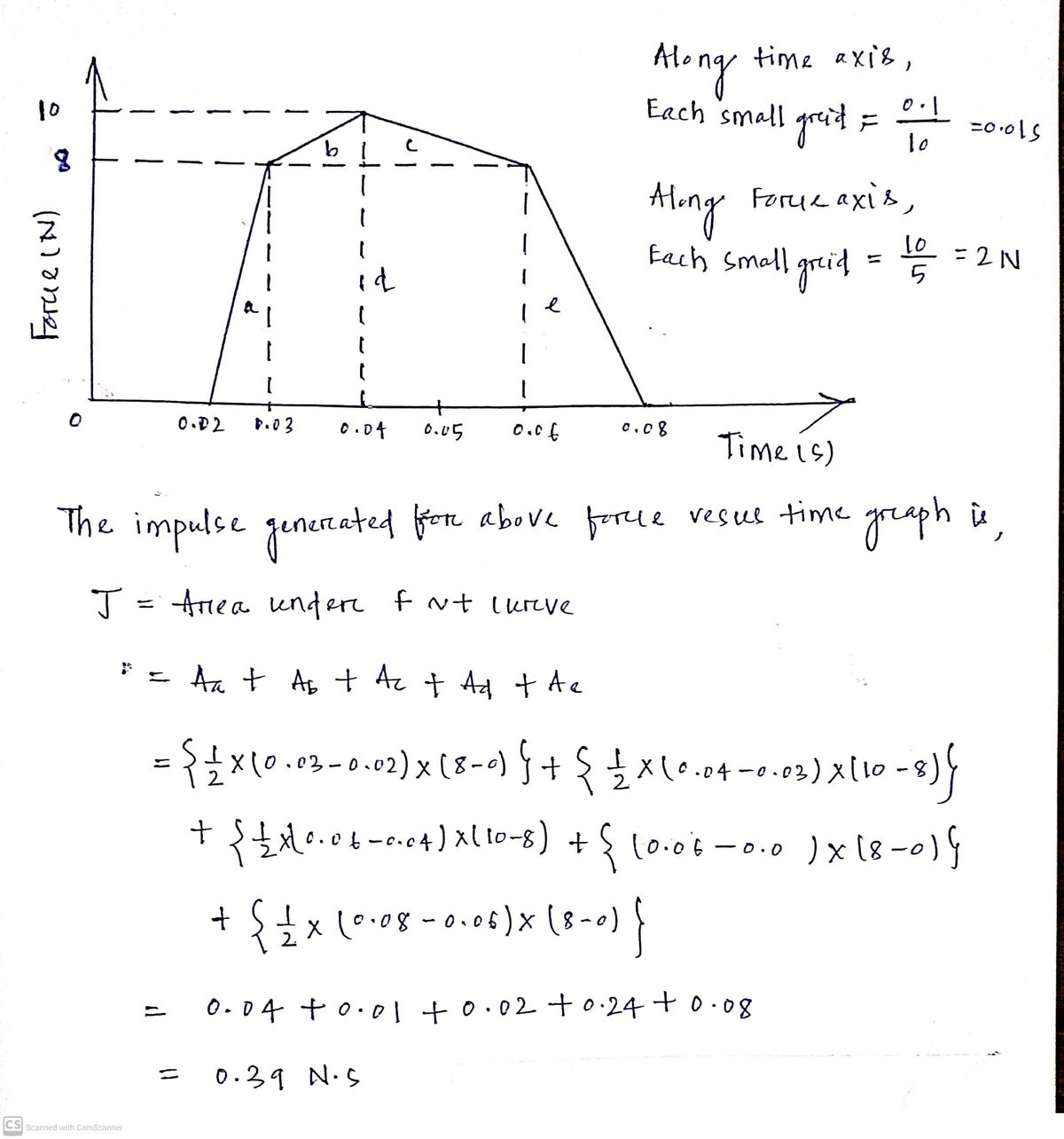A 0.250 kg toy car moving with a speed of 0.820 m/s collides with a wall. The figure shows the force exerted on the car by the wall over the course of the collision. What is the magnitude of the velocity, or final speed, of the car after the collision? Force (N) 10- 0 I 1 0.05 Time (s) 1 I 0.10 final speed= x10 TOOLS m/s
A 0.250 kg toy car moving with a speed of 0.820 m/s collides with a wall. The figure shows the force exerted on the car by the wall over the course of the collision. What is the magnitude of the velocity, or final speed, of the car after the collision? Force (N) 10- 0 I 1 0.05 Time (s) 1 I 0.10 final speed= x10 TOOLS m/s
College Physics
11th Edition
ISBN:9781305952300
Author:Raymond A. Serway, Chris Vuille
Publisher:Raymond A. Serway, Chris Vuille
Chapter1: Units, Trigonometry. And Vectors
Section: Chapter Questions
Problem 1CQ: Estimate the order of magnitude of the length, in meters, of each of the following; (a) a mouse, (b)...
Related questions
Question
Please answer and solve the question correctly. Thank you
![**Physics Problem: Collision and Force Analysis**
A 0.250 kg toy car moving with a speed of 0.820 m/s collides with a wall. The figure shows the force exerted on the car by the wall over the course of the collision.
*Question:*
What is the magnitude of the velocity, or final speed, of the car after the collision?
**Graph Analysis: Force vs. Time**
- **Axes:**
- The horizontal axis represents Time (s), ranging from 0 to 0.10 seconds.
- The vertical axis represents Force (N), ranging from 0 to 10 Newtons.
- **Curve Description:**
- The force starts at 0 Newtons and rises linearly, peaking at 10 Newtons around 0.05 seconds.
- After reaching the peak, the force decreases linearly back to 0 Newtons at 0.10 seconds.
*Calculation Section:*
- ***Final Speed = [Input Box] m/s***
**Tools:**
- Multiplier: x10
*Note: Students can use the impulse-momentum theorem to calculate the final speed of the car after the collision using the provided force-time graph.*](/v2/_next/image?url=https%3A%2F%2Fcontent.bartleby.com%2Fqna-images%2Fquestion%2F9081bc6b-9817-477c-9b8d-7c2dcc8c93d8%2F9565a132-42af-473a-9367-11adb4ac91a5%2Fszkbpwj_processed.jpeg&w=3840&q=75)
Transcribed Image Text:**Physics Problem: Collision and Force Analysis**
A 0.250 kg toy car moving with a speed of 0.820 m/s collides with a wall. The figure shows the force exerted on the car by the wall over the course of the collision.
*Question:*
What is the magnitude of the velocity, or final speed, of the car after the collision?
**Graph Analysis: Force vs. Time**
- **Axes:**
- The horizontal axis represents Time (s), ranging from 0 to 0.10 seconds.
- The vertical axis represents Force (N), ranging from 0 to 10 Newtons.
- **Curve Description:**
- The force starts at 0 Newtons and rises linearly, peaking at 10 Newtons around 0.05 seconds.
- After reaching the peak, the force decreases linearly back to 0 Newtons at 0.10 seconds.
*Calculation Section:*
- ***Final Speed = [Input Box] m/s***
**Tools:**
- Multiplier: x10
*Note: Students can use the impulse-momentum theorem to calculate the final speed of the car after the collision using the provided force-time graph.*
Expert Solution
Step 1: Impulse is found here.

Step by step
Solved in 3 steps with 2 images

Knowledge Booster
Learn more about
Need a deep-dive on the concept behind this application? Look no further. Learn more about this topic, physics and related others by exploring similar questions and additional content below.Recommended textbooks for you

College Physics
Physics
ISBN:
9781305952300
Author:
Raymond A. Serway, Chris Vuille
Publisher:
Cengage Learning

University Physics (14th Edition)
Physics
ISBN:
9780133969290
Author:
Hugh D. Young, Roger A. Freedman
Publisher:
PEARSON

Introduction To Quantum Mechanics
Physics
ISBN:
9781107189638
Author:
Griffiths, David J., Schroeter, Darrell F.
Publisher:
Cambridge University Press

College Physics
Physics
ISBN:
9781305952300
Author:
Raymond A. Serway, Chris Vuille
Publisher:
Cengage Learning

University Physics (14th Edition)
Physics
ISBN:
9780133969290
Author:
Hugh D. Young, Roger A. Freedman
Publisher:
PEARSON

Introduction To Quantum Mechanics
Physics
ISBN:
9781107189638
Author:
Griffiths, David J., Schroeter, Darrell F.
Publisher:
Cambridge University Press

Physics for Scientists and Engineers
Physics
ISBN:
9781337553278
Author:
Raymond A. Serway, John W. Jewett
Publisher:
Cengage Learning

Lecture- Tutorials for Introductory Astronomy
Physics
ISBN:
9780321820464
Author:
Edward E. Prather, Tim P. Slater, Jeff P. Adams, Gina Brissenden
Publisher:
Addison-Wesley

College Physics: A Strategic Approach (4th Editio…
Physics
ISBN:
9780134609034
Author:
Randall D. Knight (Professor Emeritus), Brian Jones, Stuart Field
Publisher:
PEARSON